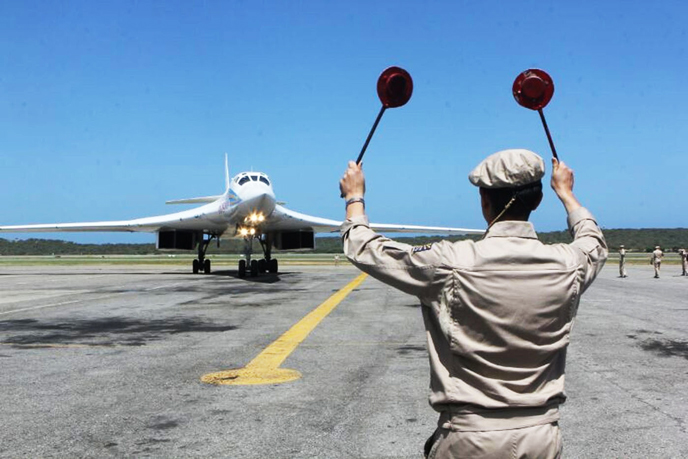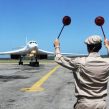
Russian Strategic Bombers Touch Down in Latin America
Publication: Eurasia Daily Monitor Volume: 10 Issue: 200
By:

Two Tu-160 Blackjack strategic bombers have flown from their permanent base in Engels airbase in the Saratov oblast on the Volga River to Venezuela on October 28. From Venezuela, the bombers patrolled the Caribbean and also landed in Managua, the capital of Nicaragua. From Managua, the Tu-160 returned for refueling to Venezuela and eventually took the long trip over the Atlantic Ocean, north of the United Kingdom and Norway, and back home to Engels on November 5. The bomber excursion into the Caribbean put the Russian military into an acute verbal conflict with Colombia, which accused the two Tu-160s of violating its airspace while flying from Venezuela to Nicaragua and back again. The Colombian ambassador in Moscow has presented a note of protest, while the Columbian military claims it had scrambled two Israeli-made Kfir jet fighters to intercept the Tu-160s. A running territorial dispute between Colombia and Nicaragua over maritime borders in the Caribbean has recently become worse after an international court ruled in Nicaragua’s favor last year—a ruling Colombia does not accept. Both Colombian and Nicaraguan naval forces have been posturing in the disputed waters that the Russian bombers apparently overflew. The Russian Ministry of Defense denied its bombers violated any international regulations (https://www.newsru.com/world/06nov2013/columb_print.html).
The Tu-160 is a modern supersonic strategic bomber, developed in the 1980s. It has a crew of four and can fly over 12,000 kilometers without refueling. The Tu-160 can carry 12 KH-55 long-range (over 3,000 km) nuclear-tipped (200 kiloton) cruise missiles in its hull. It makes military sense for Russian pilots and land crews to become acquainted with Latin America. In a possible, future, acute military crisis involving the United States and Russia, nuclear-armed strategic bombers could be dispatched to friendly Latin American client states like Venezuela or Nicaragua. There, the planes could refuel and threaten the continental US with their long-range KH-55 missiles, which could be launched from far off over the Caribbean or the Pacific. A credible nuclear threat from the south could force the US to spread out and, thus, thin its air defense capabilities while other Russian strategic bombers could be threatening to strike with long-range missiles from the Northeast Atlantic, the Northwest Pacific and over Canada from the North. The appearance of Russian strategic bombers in the region is also an important showing of the flag and a morale boost to friendly client states (https://www.bbc.co.uk/russian/russia/2013/11/131106_tu160_colombia_experts.shtml?print=1).
Russian Tu-160 bombers first landed in Venezuela in September 2008 and it took more than five years for them to reappear (see EDM, September 11, 2008). The Kremlin seems eager to play a Cold War–style superpower role on the world scene, but there are severe limitations that hamper Russian capabilities. Today, Russia officially has 16 Tu-160s, but, apparently only three or four planes are operational at any given moment. It is reported that less than 50 percent of the Russian Air Force’s overall combat jet inventory is currently operational. The most serious is the condition of the Tu-160 and Tu-22M3 Backfire bombers, as well as MiG-25 and MiG-29 fighters, which are reported to be only 20–25 percent operational (Kommersant, October 28).
Economic growth has fizzled out in Russia, and the state budget is under strain. The government has, at present, put to the Duma an austere budget with cuts in social expenditure and many other fields. Government bureaucrats, military, law enforcement and security service personnel will not get their traditional annual paycheck hike to compensate inflation in 2014, which will mean a 5–6-percent loss in real earnings. Still, defense spending on research and development (R & D) and procurement will continue to grow (https://www.ng.ru/economics/2013-11-07/1_kazna.html). According to Defense Minister Sergei Shoigu, “In 2014 and in spending plans for 2015–2016, there will be no cuts; the development and the modernization of the Armed Forces, the procurement of weapons will continue as planned.” There were serious arguments in the government, added Shoigu, “but the commander-in-chief [President Vladimir Putin] made the decision” (Interfax, October 19).
The daunting task of re-arming and modernizing Russia’s mothballed military remains a top priority for the Kremlin, but the problems being faced are immense. Finding money to increase defense spending in a time of economic stagnation and financial austerity is not easy and is politically dangerous. Ensuring the defense industry is indeed capable of producing the merchandise is another difficulty. Russia’s deputy prime minister in charge of defense production, Dmitry Rogozon, has been recently complaining about the immense problems besetting a defense industry that seems no less mothballed than the military it apparently must refurnish. “Old, worn-out equipment… Some factories it is cheaper to close than to reform,” lamented Rogozin, speaking to journalists, “We are going ahead as planned in developing new aircraft, but problems persist in making jet engines. The president [Putin] ordered a special meeting on engine building. We cannot modernize our planes if we cannot obtain jet engines” (https://www.vpk-news.ru/articles/17722).
Rogozin singled out Russia’s strategic bomber force as facing an acute jet engine problem. First reports about this had surfaced in the press years ago. In 2007, it was reported that a factory in Samara Motorostoytel has run out of stockpiles of Soviet-made components and cannot produce new NK-32 jet engines for the Tu-160. Furthermore, it has problems fixing worn-out previously-produced engines. The NK-32 was the most powerful jet engine produced in the Soviet Union during the Cold War, but as the serial production of Tu-160s slumped to less than one a year in the 1990s, production of components to make HK-32 engines also discontinued (https://www.ng.ru/regions/2007-12-20/7_samara.html). Plans were announced to restore the HK-32 production and possibly to make more Tu-160 bombers, but apparently neither happened. According to Rogozin, “Everything was lost in Samara, now we are dismantling bit by bit old engines and reassembling them to get at least several working” (https://www.vpk-news.ru/articles/17722).
It was an achievement to send two Tu-160s to Latin America and back again, but years may pass before those supersonic bombers reappear in the region. In its attempt to mimic a superpower, Putin’s Russia is too often making itself look ridiculous and is massively misspending on unachievable or senseless goals. Building up an industry to service and build NK-32 jet engines to serve a miniscule fleet of 16 Tu-160 bombers will never be profitable and, in today’s post-Communist Russia, no one wants to run a money-losing business—state propaganda about restoring Russian (Soviet) superpower glory, not withstanding.




